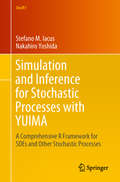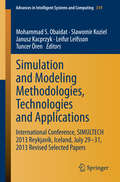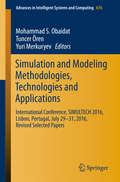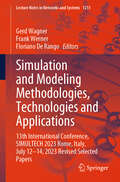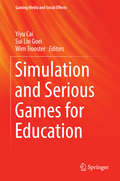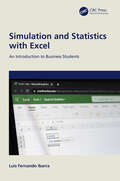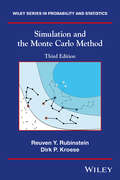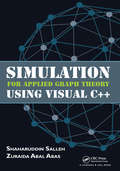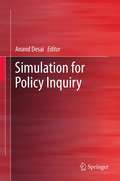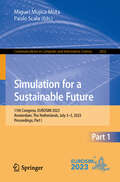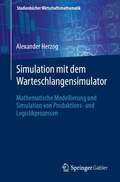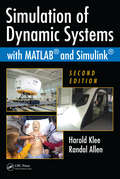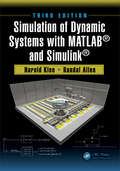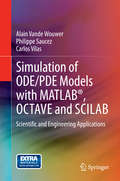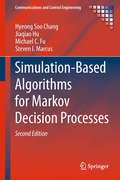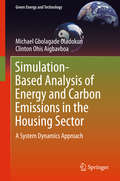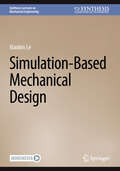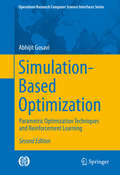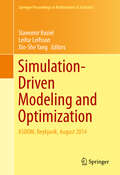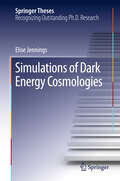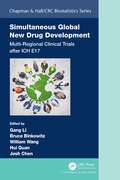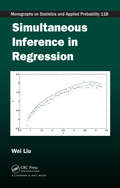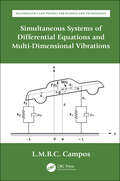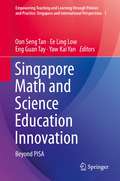- Table View
- List View
Simulation and Inference for Stochastic Processes with YUIMA: A Comprehensive R Framework for SDEs and Other Stochastic Processes (Use R!)
by Stefano M. Iacus Nakahiro YoshidaThe YUIMA package is the first comprehensive R framework based on S4 classes and methods which allows for the simulation of stochastic differential equations driven by Wiener process, Lévy processes or fractional Brownian motion, as well as CARMA, COGARCH, and Point processes. The package performs various central statistical analyses such as quasi maximum likelihood estimation, adaptive Bayes estimation, structural change point analysis, hypotheses testing, asynchronous covariance estimation, lead-lag estimation, LASSO model selection, and so on. YUIMA also supports stochastic numerical analysis by fast computation of the expected value of functionals of stochastic processes through automatic asymptotic expansion by means of the Malliavin calculus. All models can be multidimensional, multiparametric or non parametric.The book explains briefly the underlying theory for simulation and inference of several classes of stochastic processes and then presents both simulation experiments and applications to real data. Although these processes have been originally proposed in physics and more recently in finance, they are becoming popular also in biology due to the fact the time course experimental data are now available. The YUIMA package, available on CRAN, can be freely downloaded and this companion book will make the user able to start his or her analysis from the first page.
Simulation and Modeling Methodologies, Technologies and Applications
by Leifur Leifsson Slawomir Koziel Mohammad S. Obaidat Janusz Kacprzyk Tuncer ÖrenThis book includes extended and revised versions of a set of selected papers from the 3rd International Conference on Simulation and Modeling Methodologies, Technologies and Applications (SIMULTECH 2013) which was co-organized by the Reykjavik University (RU) and sponsored by the Institute for Systems and Technologies of Information, Control and Communication (INSTICC). SIMULTECH 2013 was held in cooperation with the ACM SIGSIM - Special Interest Group (SIG) on SImulation and Modeling (SIM), Movimento Italiano Modellazione e Simulazione (MIMOS) and AIS Special Interest Group on Modeling and Simulation (AIS SIGMAS) and technically co-sponsored by the Society for Modeling & Simulation International (SCS), Liophant Simulation, Simulation Team and International Federation for Information Processing (IFIP). This proceedings brings together researchers, engineers, applied mathematicians and practitioners working in the advances and applications in the field of system simulation.
Simulation and Modeling Methodologies, Technologies and Applications
by Yuri Merkuryev Mohammad S. Obaidat Tuncer ÖrenThis book includes extended and revised versions of a set of selected papers from the 2012 International Conference on Simulation and Modeling Methodologies, Technologies and Applications (SIMULTECH 2012) which was sponsored by the Institute for Systems and Technologies of Information, Control and Communication (INSTICC) and held in Rome, Italy. SIMULTECH 2012 was technically co-sponsored by the Society for Modeling & Simulation International (SCS), GDR I3, Lionphant Simulation, Simulation Team and IFIP and held in cooperation with AIS Special Interest Group of Modeling and Simulation (AIS SIGMAS) and the Movimento Italiano Modellazione e Simulazione (MIMOS).
Simulation and Modeling Methodologies, Technologies and Applications: 13th International Conference, SIMULTECH 2023 Rome, Italy, July 12-14, 2023 Revised Selected Papers (Lecture Notes in Networks and Systems #1211)
by Gerd Wagner Frank Werner Floriano De RangoThis book includes a set of selected best extended papers from the 13th International Conference on Simulation and Modeling Methodologies, Technologies and Applications (SIMULTECH 2023), that was held in Rome, Italy, from July 12 to 14. The conference brought together researchers, engineers, and practitioners interested in methodologies and applications of modeling and simulation. New and innovative solutions are reported in this book. A selection was made after the conference, based also on the conference chairs assessment, reviewers’ assessment, quality of presentation, and audience interest, so that this book includes the extended and revised versions of the very best papers of the conference. New and innovative solutions are reported in this book.
Simulation and Serious Games for Education
by Yiyu Cai Sui Lin Goei Wim TroosterThis book introduces state-of-the-art research on simulation and serious games for education. The major part of this book is based on selected work presented at the 2014 Asia-Europe Symposium on Simulation and Serious Games held in Windesheim University of Applied Sciences, the Netherlands (Oct 1-2, 2014). It covers three major domains of education applications that use simulation and serious games: Science, Technology, Engineering and Mathematics (STEM) Education; Special Needs Education and Humanity and Social Science Education. Researchers and developers in simulation and serious games for education benefit from this book, and it also offers educators and professionals involved in training insights into the possible applications of simulation and serious games in various areas.
Simulation and Statistics with Excel: An Introduction to Business Students
by Luis Fernando IbarraThe use of simulation techniques has increased in importance in recent history, and simulation activities are an important resource for advanced preparation for the organization and execution of events. When formal mathematics is not enough, simulation may be the only option capable of approximating solutions. Simulation and Statistics with Excel: An Introduction to Business Students offers a non-rigorous and practical tour of the simulation procedure on computers, using a versatile and accessible resource, the Microsoft Excel spreadsheet. This book covers the concepts essential to understanding the basic principles and approaches of statistical simulation, allowing for the study of complex systems. Aimed at students in business and operational research beginning to use simulation as an instrument for understanding existing or proposed processes, this book will lay solid foundations in understanding simulation experimentation.Key Features: Provides a basis to understand the approaches and principles of simulator experiments. Uses a universal and easily accessible resource. Introduces simple examples to teach the fundamentals of simulation.
Simulation and the Monte Carlo Method
by Dirk P. Kroese Reuven Y. RubinsteinThis accessible new edition explores the major topics in Monte Carlo simulationSimulation and the Monte Carlo Method, Second Edition reflects the latest developments in the field and presents a fully updated and comprehensive account of the major topics that have emerged in Monte Carlo simulation since the publication of the classic First Edition over twenty-five years ago. While maintaining its accessible and intuitive approach, this revised edition features a wealth of up-to-date information that facilitates a deeper understanding of problem solving across a wide array of subject areas, such as engineering, statistics, computer science, mathematics, and the physical and life sciences.The book begins with a modernized introduction that addresses the basic concepts of probability, Markov processes, and convex optimization. Subsequent chapters discuss the dramatic changes that have occurred in the field of the Monte Carlo method, with coverage of many modern topics including:Markov Chain Monte CarloVariance reduction techniques such as the transform likelihood ratio method and the screening methodThe score function method for sensitivity analysisThe stochastic approximation method and the stochastic counter-part method for Monte Carlo optimizationThe cross-entropy method to rare events estimation and combinatorial optimizationApplication of Monte Carlo techniques for counting problems, with an emphasis on the parametric minimum cross-entropy methodAn extensive range of exercises is provided at the end of each chapter, with more difficult sections and exercises marked accordingly for advanced readers. A generous sampling of applied examples is positioned throughout the book, emphasizing various areas of application, and a detailed appendix presents an introduction to exponential families, a discussion of the computational complexity of stochastic programming problems, and sample MATLAB programs.Requiring only a basic, introductory knowledge of probability and statistics, Simulation and the Monte Carlo Method, Second Edition is an excellent text for upper-undergraduate and beginning graduate courses in simulation and Monte Carlo techniques. The book also serves as a valuable reference for professionals who would like to achieve a more formal understanding of the Monte Carlo method.
Simulation for Applied Graph Theory Using Visual C++
by Shaharuddin Salleh Zuraida Abal AbasThe tool for visualization is Microsoft Visual C++. This popular software has the standard C++ combined with the Microsoft Foundation Classes (MFC) libraries for Windows visualization. This book explains how to create a graph interactively, solve problems in graph theory with minimum number of C++ codes, and provide friendly interfaces that makes learning the topics an interesting one. Each topic in the book comes with working Visual C++ codes which can easily be adapted as solutions to various problems in science and engineering.
Simulation for Policy Inquiry
by Anand DesaiPublic policy and management problems have been described as poorly defined, messy, squishy, unstructured, intractable, and wicked. In a word, they are complex. This book illustrates the development and use of simulation models designed to capture some of the complexity inherent in the formulation, management, and implementation of policies aimed at addressing such problems. Simulation models have long existed at the fringes of policy inquiry but are not yet considered an essential component of the policy analyst's toolkit. However, this situation is likely to change because with improvements in computational power and software, simulation is now easier to include in the standard repertoire of research tools available for discovery and decision support. This volume provides both a conceptual rationale for using simulations to inform public policy and a practical introduction to how such models might be constructed and employed. The focus of these papers is on the uses of simulation to gain understanding and inform policy decisions and action. Techniques represented in this volume include Monte Carlo simulation, system dynamics and agent based modeling.
Simulation for a Sustainable Future: 11th Congress, EUROSIM 2023, Amsterdam, The Netherlands, July 3–5, 2023, Proceedings, Part I (Communications in Computer and Information Science #2032)
by Miguel Mujica Mota Paolo ScalaThe two volume set CCIS 2032 and 2033 constitutes the proceedings of the 11th Congress on Simulation for a Sustainable Future, EUROSIM 2023, which was held in Amsterdam, The Netherlands, during July 3–5, 2023. The 47 full papers included in the proceedings were carefully reviewed and selected from 99 submissions. The papers are divided in the following topical sections: environmental sustainability; healthcare; production systems; business and industries; logistics and transportation systems; monitor, control, and theoretical systems.
Simulation mit dem Warteschlangensimulator: Mathematische Modellierung und Simulation von Produktions- und Logistikprozessen (Studienbücher Wirtschaftsmathematik)
by Alexander HerzogDieses Buch verknüpft die mathematischen Grundlagen der Warteschlangentheorie mit der Modellierung praktischer Problemstellungen, der Anwendung entsprechender Simulationen und der validen Auswertung ihrer Ergebnisse. In zahlreichen konkreten Beispielen und Fragestellungen kommt der frei verfügbare Warteschlangensimulator zum Einsatz, so dass alles nachvollzogen und für eigene Zwecke adaptiert werden kann. Das Buch bildet somit eine solide Basis für den erfolgreichen Einsatz von Warteschlangensimulationen, etwa zur Planung von Produktions- und Logistikprozessen: Mathematiker erhalten hier neue Impulse und Anwender aus der industriellen Praxis einen gut zugänglichen Einstieg in das Thema.
Simulation of Additive Manufacturing using Meshfree Methods: With Focus on Requirements for an Accurate Solution (Lecture Notes in Applied and Computational Mechanics #97)
by Christian WeißenfelsThis book provides a detailed instruction to virtually reproduce the processes of Additive Manufacturing on a computer. First, all mathematical equations needed to model these processes are presented. Due to their flexibility, meshfree methods represent optimal computational solution schemes to simulate Additive Manufacturing processes. On the other hand, these methods usually do not guarantee an accurate solution. For this reason, this monograph is dedicated in detail to the necessary criteria for computational solution schemes to provide accurate results. Several meshfree methods are examined with respect to these conditions. Two different 3D printing techniques are presented in detail. The results obtained from the simulation are investigated and compared with experimental data. This work is addressed to both scientists and professionals working in the field of development who are interested to learn the secrets behind meshfree methods or get into the modeling of Additive Manufacturing.
Simulation of Dynamic Systems with MATLAB and Simulink
by Harold Klee Randal Allen"� a seminal text covering the simulation design and analysis of a broad variety of systems using two of the most modern software packages available today. � particularly adept [at] enabling students new to the field to gain a thorough understanding of the basics of continuous simulation in a single semester, and [also provides] a more advanced tre
Simulation of Dynamic Systems with MATLAB® and Simulink®
by Harold Klee Randal AllenContinuous-system simulation is an increasingly important tool for optimizing the performance of real-world systems. The book presents an integrated treatment of continuous simulation with all the background and essential prerequisites in one setting. It features updated chapters and two new sections on Black Swan and the Stochastic Information Packet (SIP) and Stochastic Library Units with Relationships Preserved (SLURP) Standard. The new edition includes basic concepts, mathematical tools, and the common principles of various simulation models for different phenomena, as well as an abundance of case studies, real-world examples, homework problems, and equations to develop a practical understanding of concepts.
Simulation of ODE/PDE Models with MATLAB®, OCTAVE and SCILAB
by Alain Vande Wouwer Philippe Saucez Carlos VilasSimulation of ODE/PDE Models with MATLAB®, OCTAVE and SCILAB shows the reader how to exploit a fuller array of numerical methods for the analysis of complex scientific and engineering systems than is conventionally employed. The book is dedicated to numerical simulation of distributed parameter systems described by mixed systems of algebraic equations, ordinary differential equations (ODEs) and partial differential equations (PDEs). Special attention is paid to the numerical method of lines (MOL), a popular approach to the solution of time-dependent PDEs, which proceeds in two basic steps: spatial discretization and time integration. Besides conventional finite-difference and element techniques, more advanced spatial-approximation methods are examined in some detail, including nonoscillatory schemes and adaptive-grid approaches. A MOL toolbox has been developed within MATLAB®/OCTAVE/SCILAB. In addition to a set of spatial approximations and time integrators, this toolbox includes a collection of application examples, in specific areas, which can serve as templates for developing new programs. Simulation of ODE/PDE Models with MATLAB®, OCTAVE and SCILAB provides a practical introduction to some advanced computational techniques for dynamic system simulation, supported by many worked examples in the text, and a collection of codes available for download from the book's page at www. springer. com. This text is suitable for self-study by practicing scientists and engineers and as a final-year undergraduate course or at the graduate level.
Simulation-Based Algorithms for Markov Decision Processes
by Hyeong Soo Chang Steven I. Marcus Michael C. Fu Jiaqiao HuMarkov decision process (MDP) models are widely used for modeling sequential decision-making problems that arise in engineering, economics, computer science, and the social sciences. Many real-world problems modeled by MDPs have huge state and/or action spaces, giving an opening to the curse of dimensionality and so making practical solution of the resulting models intractable. In other cases, the system of interest is too complex to allow explicit specification of some of the MDP model parameters, but simulation samples are readily available (e.g., for random transitions and costs). For these settings, various sampling and population-based algorithms have been developed to overcome the difficulties of computing an optimal solution in terms of a policy and/or value function. Specific approaches include adaptive sampling, evolutionary policy iteration, evolutionary random policy search, and model reference adaptive search. This substantially enlarged new edition reflects the latest developments in novel algorithms and their underpinning theories, and presents an updated account of the topics that have emerged since the publication of the first edition. Includes: innovative material on MDPs, both in constrained settings and with uncertain transition properties; game-theoretic method for solving MDPs; theories for developing roll-out based algorithms; and details of approximation stochastic annealing, a population-based on-line simulation-based algorithm. The self-contained approach of this book will appeal not only to researchers in MDPs, stochastic modeling, and control, and simulation but will be a valuable source of tuition and reference for students of control and operations research.
Simulation-Based Analysis of Energy and Carbon Emissions in the Housing Sector: A System Dynamics Approach (Green Energy And Technology)
by Michael Gbolagade Oladokun Clinton Ohis AigbavboaThis book describes the development of a system dynamics-based model that can capture the future trajectories of housing energy and carbon emissions. It approaches energy and carbon emissions in the housing sector as a complex socio-technical problem involving the analysis of intrinsic interrelationships among dwellings, occupants and the environment. Based on an examination of the UK housing sector but with relevance worldwide, the book demonstrates how the systems dynamics simulation can be used as a learning laboratory regarding future trends in housing energy and carbon emissions. The authors employ a pragmatic research strategy, involving the collection of both qualitative and quantitative data to develop a model. The book enriches readers’ understanding of the complexity involved in housing energy and carbon emissions from a systems-thinking perspective. As such, it will be of interest to researchers in the fields of architectural engineering, housing studies and climate change, while also appealing to industry practitioners and policymakers specializing in housing energy.
Simulation-Based Mechanical Design (Synthesis Lectures on Mechanical Engineering)
by Xiaobin LeThis book establishes a modern practical approach to mechanical design. It introduces a full set of mechanical design theories and approaches to conduct and complete mechanical design tasks. The book uses Finite-Element Analysis (FEA) as a mechanical engineering tool to calculate stress/strain and then integrate it with failure theory to complete the mechanical design. FEA simulation always evaluates the stress and strain of any component/assembly no matter whether components/assemblies have complicated geometries and/or are under complicated loading conditions.
Simulation-Based Optimization
by Abhijit GosaviSimulation-Based Optimization: Parametric Optimization Techniques and Reinforcement Learning introduce the evolving area of static and dynamic simulation-based optimization. Covered in detail are model-free optimization techniques - especially designed for those discrete-event, stochastic systems which can be simulated but whose analytical models are difficult to find in closed mathematical forms. Key features of this revised and improved Second Edition include: · Extensive coverage, via step-by-step recipes, of powerful new algorithms for static simulation optimization, including simultaneous perturbation, backtracking adaptive search and nested partitions, in addition to traditional methods, such as response surfaces, Nelder-Mead search and meta-heuristics (simulated annealing, tabu search, and genetic algorithms) · Detailed coverage of the Bellman equation framework for Markov Decision Processes (MDPs), along with dynamic programming (value and policy iteration) for discounted, average, and total reward performance metrics · An in-depth consideration of dynamic simulation optimization via temporal differences and Reinforcement Learning: Q-Learning, SARSA, and R-SMART algorithms, and policy search, via API, Q-P-Learning, actor-critics, and learning automata · A special examination of neural-network-based function approximation for Reinforcement Learning, semi-Markov decision processes (SMDPs), finite-horizon problems, two time scales, case studies for industrial tasks, computer codes (placed online) and convergence proofs, via Banach fixed point theory and Ordinary Differential Equations Themed around three areas in separate sets of chapters - Static Simulation Optimization, Reinforcement Learning and Convergence Analysis - this book is written for researchers and students in the fields of engineering (industrial, systems, electrical and computer), operations research, computer science and applied mathematics.
Simulation-Driven Modeling and Optimization
by Leifur Leifsson Slawomir Koziel Xin-She YangThis edited volume is devoted to the now-ubiquitous use of computational models across most disciplines of engineering and science, led by a trio of world-renowned researchers in the field. Focused on recent advances of modeling and optimization techniques aimed at handling computationally-expensive engineering problems involving simulation models, this book will be an invaluable resource for specialists (engineers, researchers, graduate students) working in areas as diverse as electrical engineering, mechanical and structural engineering, civil engineering, industrial engineering, hydrodynamics, aerospace engineering, microwave and antenna engineering, ocean science and climate modeling, and the automotive industry, where design processes are heavily based on CPU-heavy computer simulations. Various techniques, such as knowledge-based optimization, adjoint sensitivity techniques, and fast replacement models (to name just a few) are explored in-depth along with an array of the latest techniques to optimize the efficiency of the simulation-driven design process. High-fidelity simulation models allow for accurate evaluations of the devices and systems, which is critical in the design process, especially to avoid costly prototyping stages. Despite this and other advantages, the use of simulation tools in the design process is quite challenging due to associated high computational cost. The steady increase of available computational resources does not always translate into the shortening of the design cycle because of the growing demand for higher accuracy and necessity to simulate larger and more complex systems. For this reason, automated simulation-driven design--while highly desirable--is difficult when using conventional numerical optimization routines which normally require a large number of system simulations, each one already expensive.
Simulations of Dark Energy Cosmologies
by Elise JenningsA major outstanding problem in physics is understanding the nature of the dark energy that is driving the accelerating expansion of the Universe. This thesis makes a significant contribution by demonstrating, for the first time, using state-of-the-art computer simulations, that the interpretation of future galaxy survey measurements is far more subtle than is widely assumed, and that a major revision to our models of these effects is urgently needed. The work contained in the thesis was used by the WiggleZ dark energy survey to measure the growth rate of cosmic structure in 2011 and had a direct impact on the design of the surveys to be conducted by the European Space Agency's Euclid mission, a 650 million euro project to measure dark energy.
Simultaneous Global New Drug Development: Multi-Regional Clinical Trials after ICH E17 (Chapman & Hall/CRC Biostatistics Series)
by Gang LiGlobal simultaneous development is becoming more necessary as the cost of developing medical products continues to grow. The strategy of using multiregional clinical trials (MRCTs) has become the preferred method for developing new medicines. Implementing the same protocol to include subjects from many geographical regions around the world, MRCTs can speed up the patient enrolment, thus resulting in quicker drug development and obtaining faster approval of the drug globally. After the publication of the editors’ first volume on this topic, there have been new developments on MRCTs. The International Council for Harmonisation (ICH) issued ICH E17, a guideline document on MRCTs, in November 2017, laying out principles on MRCTs. Beyond E17, new methodologies have been developed as well. Simultaneous Global New Drug Development: Multi-Regional Clinical Trials after ICH E17 collects chapters providing interpretations of principles in ICH E17 and new ideas of implementing MRCTs. Authors are from different regions, and from academia and industry. In addition, in contrast to the first book, new perspectives are brought to MRCT from regulatory agencies. This book will be of particular interest to biostatisticians working in late stage clinical development of medical products. It will also be especially helpful for statisticians in regulatory agencies, and medical research institutes. This book is comprehensive across the MRCT topic spectrum, including Issues regarding ICH E17 Implementation MRCT Design and Analysis Methodologies Perspectives from authorities in regulatory agencies, as well as statisticians practicing in the medical product industry Many examples of real-life applications based on actual MRCTs.
Simultaneous Inference in Regression (Chapman & Hall/CRC Monographs on Statistics and Applied Probability)
by Wei LiuSimultaneous confidence bands enable more intuitive and detailed inference of regression analysis than the standard inferential methods of parameter estimation and hypothesis testing. Simultaneous Inference in Regression provides a thorough overview of the construction methods and applications of simultaneous confidence bands for various inferentia
Simultaneous Systems of Differential Equations and Multi-Dimensional Vibrations (Mathematics and Physics for Science and Technology)
by Luis Manuel Braga da Costa CamposSimultaneous Differential Equations and Multi-Dimensional Vibrations is the fourth book within Ordinary Differential Equations with Applications to Trajectories and Vibrations, Six-volume Set. As a set, they are the fourth volume in the series Mathematics and Physics Applied to Science and Technology. This fourth book consists of two chapters (chapters 7 and 8 of the set). The first chapter concerns simultaneous systems of ordinary differential equations and focuses mostly on the cases that have a matrix of characteristic polynomials, namely linear systems with constant or homogeneous power coefficients. The method of the matrix of characteristic polynomials also applies to simultaneous systems of linear finite difference equations with constant coefficients. The second chapter considers linear multi-dimensional oscillators with any number of degrees of freedom including damping, forcing, and multiple resonance. The discrete oscillators may be extended from a finite number of degrees-of-freedom to infinite chains. The continuous oscillators correspond to waves in homogeneous or inhomogeneous media, including elastic, acoustic, electromagnetic, and water surface waves. The combination of propagation and dissipation leads to the equations of mathematical physics. Presents simultaneous systems of ordinary differential equations and their elimination for a single ordinary differential equation Includes cases with a matrix of characteristic polynomials, including simultaneous systems of linear differential and finite difference equations with constant coefficients Covers multi-dimensional oscillators with damping and forcing, including modal decomposition, natural frequencies and coordinates, and multiple resonance Discusses waves in inhomogeneous media, such as elastic, electromagnetic, acoustic, and water waves Includes solutions of partial differential equations of mathematical physics by separation of variables leading to ordinary differential equations
Singapore Math and Science Education Innovation: Beyond PISA (Empowering Teaching and Learning through Policies and Practice: Singapore and International Perspectives #1)
by Ee Ling Low Oon Seng Tan Eng Guan Tay Yaw Kai YanThis edited volume explores key areas of interests in Singapore math and science education including issues on teacher education, pedagogy, curriculum, assessment, teaching practices, applied learning, ecology of learning, talent grooming, culture of science and math, vocational education and STEM. It presents to policymakers and educators a clear picture of the education scene in Singapore and insights into the role of math and science education in helping the country excel beyond international studies such as PISA, the pedagogical and curricula advancements in math and science learning, and the research and practices that give Singaporean students the competitive edge in facing the uncertain and challenging landscape of the future.
